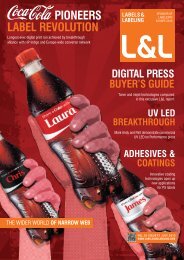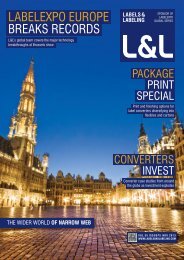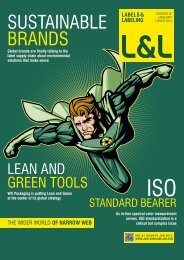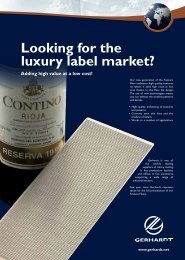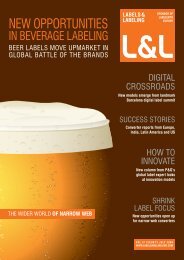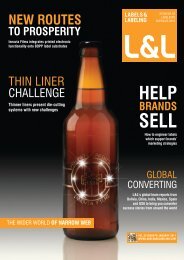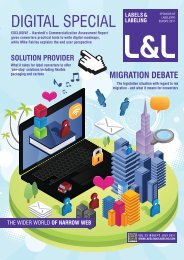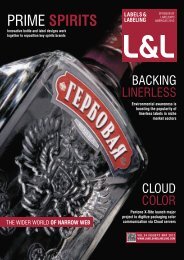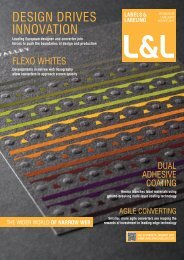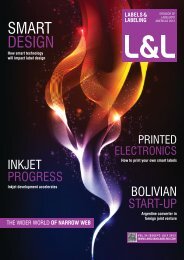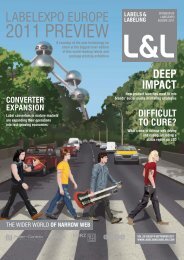THE DATA FRONT
Download as PDF - Labels & Labeling
Download as PDF - Labels & Labeling
- No tags were found...
Create successful ePaper yourself
Turn your PDF publications into a flip-book with our unique Google optimized e-Paper software.
72 | l&l<br />
Federal<br />
Etiquetas Electronicas is ISO 9000<br />
certified and is continually working<br />
to achieve more certifications or find<br />
other ways to improve quality. In 2008<br />
the converter earned the PROFEPA<br />
certification – Procuraduria Federal de<br />
Protection al Ambiente – a federally<br />
backed certificate given to Mexican<br />
manufacturing companies that meet<br />
a benchmark for clean processes.<br />
SA 8000 certification<br />
Enforced by Social Accountability<br />
International, the SA 8000 standard sets a<br />
global benchmark for working conditions that<br />
awards certificates of compliance through<br />
a third-party auditing service. The countries<br />
with the most certifications to SA8000<br />
include Brazil, India, China and Italy.<br />
For two years prior to this accomplishment, Etiquetas Electronicas gathered and<br />
documented detailed information on its manufacturing methods, focusing on air,<br />
water and toxic waste issues. Etiquetas Electronicas is required to compile and<br />
submit updated reports each quarter while the PROFEPA is valid. After three years,<br />
the company will need to re-apply.<br />
‘This certification process has pushed us to have even more order and to be more<br />
efficient in our manufacturing,’ explains the owner Casillas Sanchez. ‘We invested<br />
in this process improvement, firstly because our customers began to request<br />
information, and secondly, we saw there would be financial benefits to our bottom<br />
line. We have reduced our waste and commit fewer mistakes.’<br />
Sanchez says that employees have been eager to participate because they like to<br />
be a part of it. ‘It gives them ownership,’ he says. ‘And a sense of working together.’<br />
Alliances<br />
The switch from local buyers to a single appointed international buyer has driven<br />
the increase of acquisitions and strategic partnerships within the label and<br />
packaging industry. To bolster its competitiveness in the midst of this evolution,<br />
Flexoprint established an alliance with Brazil-based Baumgarten Group and the<br />
Swiss converter Banfix, part of the tesa group, in 2002. Together the converters<br />
share production for the Nivea brand across three continents. ‘We formed this<br />
alliance in an attempt to follow the structure of these multinational companies,’<br />
Flexoprint’s Fernando Aranguren says.<br />
‘One approval is easier for our customers.’ In their attempt to standardize<br />
their labels worldwide, CPGs will look for other alternatives if they cannot find<br />
consistency.<br />
With the Nivea brand, the three alliance partners exchange color targets and other<br />
technical information to ensure that packaging is identical no matter where it is<br />
sourced from.<br />
‘We have become a better supplier through learning how to service these big<br />
global CPGs,’ Aranguren explains. ‘It has helped us to focus on efficiency and to<br />
shorten response times with less lead-time. In the brand owner’s transition from<br />
local to global we have learned to be more flexible and provide better service than<br />
our local competition.’<br />
Aranguren comments on the choice of an alliance strategy: ‘An acquisition can be<br />
a headache and no one wanted to spend the money on a greenfield site, so the only<br />
choice left was to put our services together. We have a similar technical base and<br />
share business values on important issues like technology investment and employee<br />
training. For Flexoprint, the alliance was a turning point because the experience and<br />
infrastructure that the experience has brought to our company is invaluable.’<br />
In a less formal partnership, Impresos Uyeda has a joint venture agreement with<br />
Labelhouse, which is capable of producing shrink sleeve labels. Because Uyedas<br />
plans to explore the possibilities of digital printing first, it will not be investing in<br />
shrink sleeve equipment. Masayi at Uyeda says, ‘To service our customers in this<br />
area of product decoration, we’ve chosen to work with Labelhouse; they have the<br />
technology. And once we invest in digital printing, we will be able to share that<br />
technology with them.’<br />
Obstacles<br />
Mexican converters highlighted support from suppliers as the most difficult obstacle<br />
to success; most view globalization as an opportunity to overcome this challenge.<br />
Villar from young Promographics says, ‘Globalization is an opportunity to have<br />
access to new materials suppliers that offer a fresh selection. And in this way we<br />
are able to move past the big suppliers that don’t provide enough support.’<br />
Raw material costs were noted as the next most frequent barrier to growth.<br />
Jose casillas Sanchez of Etiquetas Electronics with<br />
Federal Green certificate<br />
Hernandez from Todo en Etiquetas believes<br />
that, ‘globalization is good because not only<br />
does competition make our company better,<br />
as we grow and continue to consume more<br />
supplies, we are able to get a better price.<br />
And this allows us to compete even better.’<br />
Price pressures were listed as the next<br />
biggest problem in the market. Yet Nueva<br />
Latina says the dynamics have changed<br />
some recently. Comments Juan Antonio<br />
Alducin, ‘Brand owners are no longer buying<br />
less expensive labels from Asia and Latin<br />
America. We have seen them begin to look<br />
within the country because of the recession.’<br />
In the last year, TLMI’s past president<br />
John Hickey of Smyth Companies, and<br />
current president Frank Grace of Multi-Color<br />
Corporation, have both said that the number<br />
one way for North American converters to<br />
diversify is to look outside the region. And,<br />
while this may be true, one closer step<br />
could be a partnership with an eager and<br />
competitive converter to the South across the<br />
Rio Grande. A relationship, at the very least,<br />
would be helpful.<br />
In fact, to foster this notion, the TLMI<br />
has introduced a new Global Committee<br />
that will guide the association across<br />
borders to strengthen the bridge between<br />
the smaller markets within the North and<br />
South American regions. Committee Chair,<br />
John Wurzburger, says, ‘The association’s<br />
converter and supplier members will<br />
benefit from forming relationships with their<br />
progressive Latin American counterparts.<br />
Borders are shrinking and globalization<br />
continues to be a central issue.’<br />
Labels&Labeling



